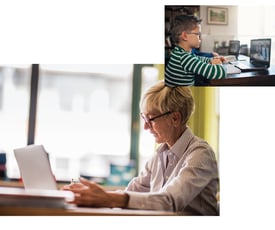Dr. Kathryn Kennedy has over 15 years of experience in online, blended, and digital learning in PreK-12, higher education, and beyond. Her work is focused at the intersection of research, practice, and policy. She owns and operates her own consulting firm that is currently helping inform PLTW’s current and future teaching and learning experiences.
In the mid-1990s, there was a phrase - “Digital Native” - that became popular among educators. The phrase, coined by a former educator named Marc Prensky, refers to “a person born or brought up during the age of digital technology” who is “therefore familiar with computers and the internet from an early age” (Oxford Languages). Prensky himself mentioned in a 2001 essay that "our students today are all native speakers of the digital language of computers, video games, and the internet."
A little more than 20 years after Prensky introduced the idea of the Digital Native, COVID-19 has caused almost every school, district, and program to shift to some form of online or blended learning structure that is supported by technology. The idea of the Digital Native has a number of issues that arise in practice that are outlined below, and these can help schools and districts inform their process for supporting students and teachers as they roll out digital learning initiatives.
- Don’t assume students have access to technology. As schools, programs, and districts grappled with and continue to grapple with school reopening plans, one of the major areas they are focusing on is students’ access to technology devices as well as internet access. Without acknowledging students’ access to technology and internet, gaps in learning can result, such as the homework gap. This phenomenon is when teachers assign homework online for students and don’t realize that some students do not have the device and/or the internet access students need to do the work.
- Don’t assume students know how to use technology, especially for learning. Once you give students devices, make sure to provide them guidance on how to use it. Additionally, if there are any applications, software, or hardware that they also need to learn, be sure to factor in time to provide instruction on that as well.
- Don’t assume students enjoy using technology. This is another area we need to be mindful about as we engage with students online. Not all of them are going to enjoy using technology.
- Don’t assume teachers who grew up in the age of technology have access to technology. In addition to our students, we want to make sure not to assume that our teachers have access to technology and internet access. Ensuring that they do is crucial, especially with all of the uncertainty of post-COVID learning.
- Don’t assume teachers who grew up in the age of technology know how to use technology. When asked to engage with technology for teaching and learning, teachers should be provided with professional learning on how to use the technology and, specifically, how to use the technology in their content area.
- Don’t assume teachers who grew up in the age of technology know how to use technology for teaching and learning. Beyond technology training, teachers should be provided pedagogical training for the setting in which they are teaching - online, blended, etc. There are differences in how to teach in each of these settings compared to in-school settings, so in order to best support your educators, make sure they’re trained pedagogically for their teaching and learning environment.
When assumptions like the ones mentioned above are made, gaps like the homework gap and digital literacy gap can arise. From there, achievement gaps can increase, as well as equity gaps. With intentional planning and attention to equity and access in learning with technology, schools, districts, and programs can make informed decisions to make sure that all students and their educators have what they need to thrive in whatever environment(s) they are learning.
PLTW’s blog intends to serve as a forum for ideas and perspectives from across our network. The opinions expressed are those of each guest author.


